2020 TOYOTA HILUX Assis
[x] Cancel search: AssisPage 253 of 744
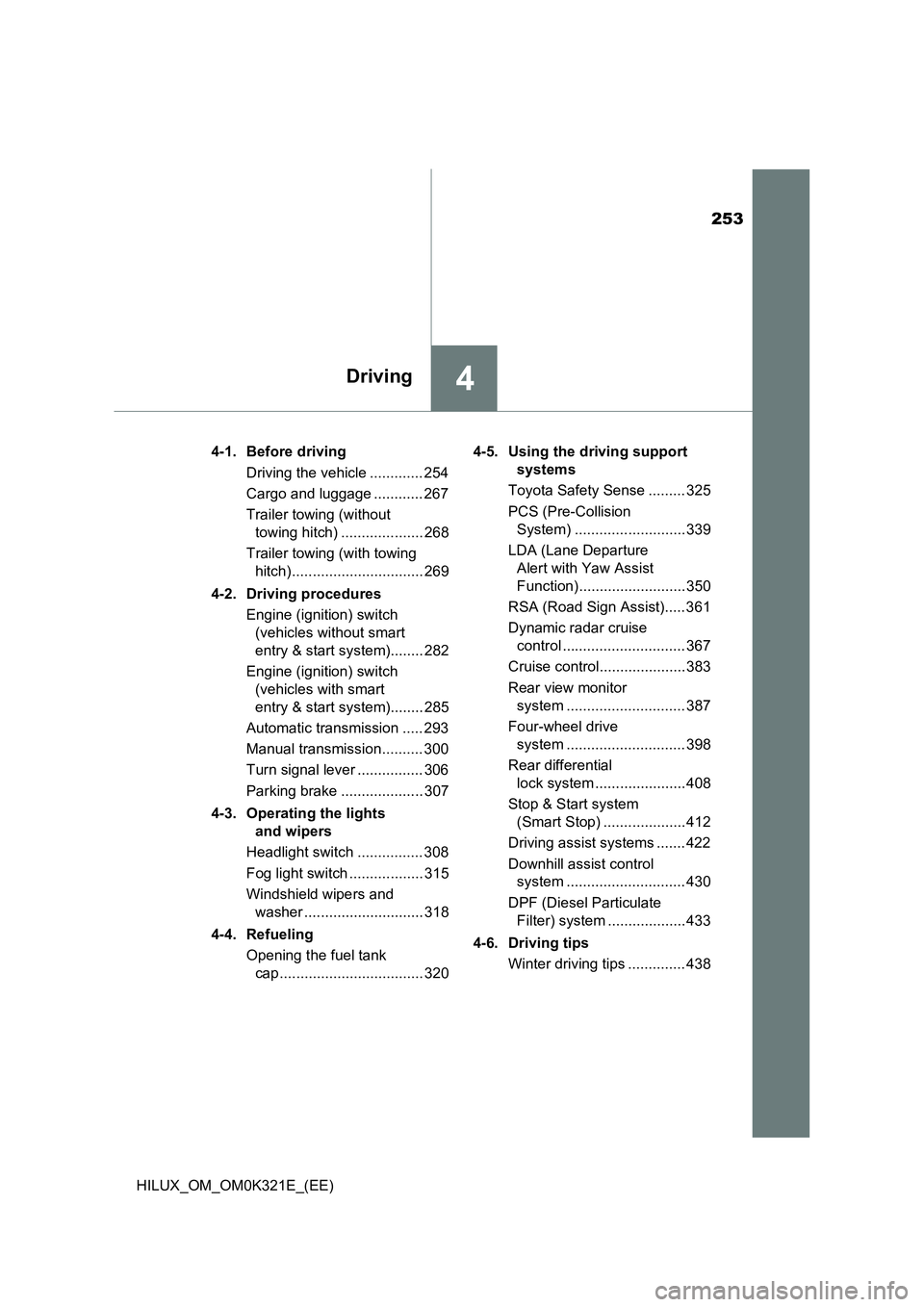
253
4Driving
HILUX_OM_OM0K321E_(EE)
4-1. Before driving
Driving the vehicle ............. 254
Cargo and luggage ............ 267
Trailer towing (without
towing hitch) .................... 268
Trailer towing (with towing
hitch)................................ 269
4-2. Driving procedures
Engine (ignition) switch
(vehicles without smart
entry & start system)........ 282
Engine (ignition) switch
(vehicles with smart
entry & start system)........ 285
Automatic transmission ..... 293
Manual transmission.......... 300
Turn signal lever ................ 306
Parking brake .................... 307
4-3. Operating the lights
and wipers
Headlight switch ................ 308
Fog light switch .................. 315
Windshield wipers and
washer ............................. 318
4-4. Refueling
Opening the fuel tank
cap ................................... 320
4-5. Using the driving support
systems
Toyota Safety Sense ......... 325
PCS (Pre-Collision
System) ........................... 339
LDA (Lane Departure
Alert with Yaw Assist
Function).......................... 350
RSA (Road Sign Assist)..... 361
Dynamic radar cruise
control .............................. 367
Cruise control..................... 383
Rear view monitor
system ............................. 387
Four-wheel drive
system ............................. 398
Rear differential
lock system ...................... 408
Stop & Start system
(Smart Stop) .................... 412
Driving assist systems ....... 422
Downhill assist control
system ............................. 430
DPF (Diesel Particulate
Filter) system ................... 433
4-6. Driving tips
Winter driving tips .............. 438
Page 257 of 744

2574-1. Before driving
4
Driving
HILUX_OM_OM0K321E_(EE)
■When starting off on an uphill (vehicles with hill-start assist control sys-
tem)
The hill-start assist control will activate. ( P. 422)
■ Driving in the rain
● Drive carefully when it is raining, because visibility will be reduced, the win-
dows may become fogged-up, and the road will be slippery.
● Drive carefully when it starts to rain, because the road surface will be espe-
cially slippery.
● Refrain from high speeds when driving on an expressway in the rain,
because there may be a layer of water between the tires and the road sur-
face, preventing the steering and brakes from operating properly.
■ Engine speed while driving (automatic transmission)
In the following conditions, the engine speed may become high while driving.
This is due to automatic up-shifting c ontrol or down-shifting implementation to
meet driving conditions. It does not indicate sudden acceleration.
● The vehicle is judged to be driving uphill or downhill
● When the accelerator pedal is released
■ Restraining the engine output (Brake Override System)
● When the accelerator and brake pedals are depressed at the same time, the
engine output may be restrained.
● Vehicles without multi-information display: A warning light comes on while
the system is operating. ( P. 637)
● Vehicles with multi-information display: A warning message is displayed on
the multi-information display while the system is operating. ( P. 645)
■ Breaking in your new Toyota
To extend the life of the vehicle, observing the following precautions is recom-
mended:
● For the first 300 km (200 miles):
Avoid sudden stops.
● For the first 800 km (500 miles) (models for model code destination W*):
Do not tow a trailer. ( P. 269)
*: See “Checking your vehicle’s model” if you are not sure of which model
your vehicle is. ( P. 1 2 )
● For the first 1000 km (600 miles):
• Do not drive at extremely high speeds.
• Avoid sudden acceleration.
• Do not drive continuously in the low gears.
• Do not drive at a constant speed for extended periods.
• Do not drive slowly with the manual transmission in a high gear.
Page 259 of 744
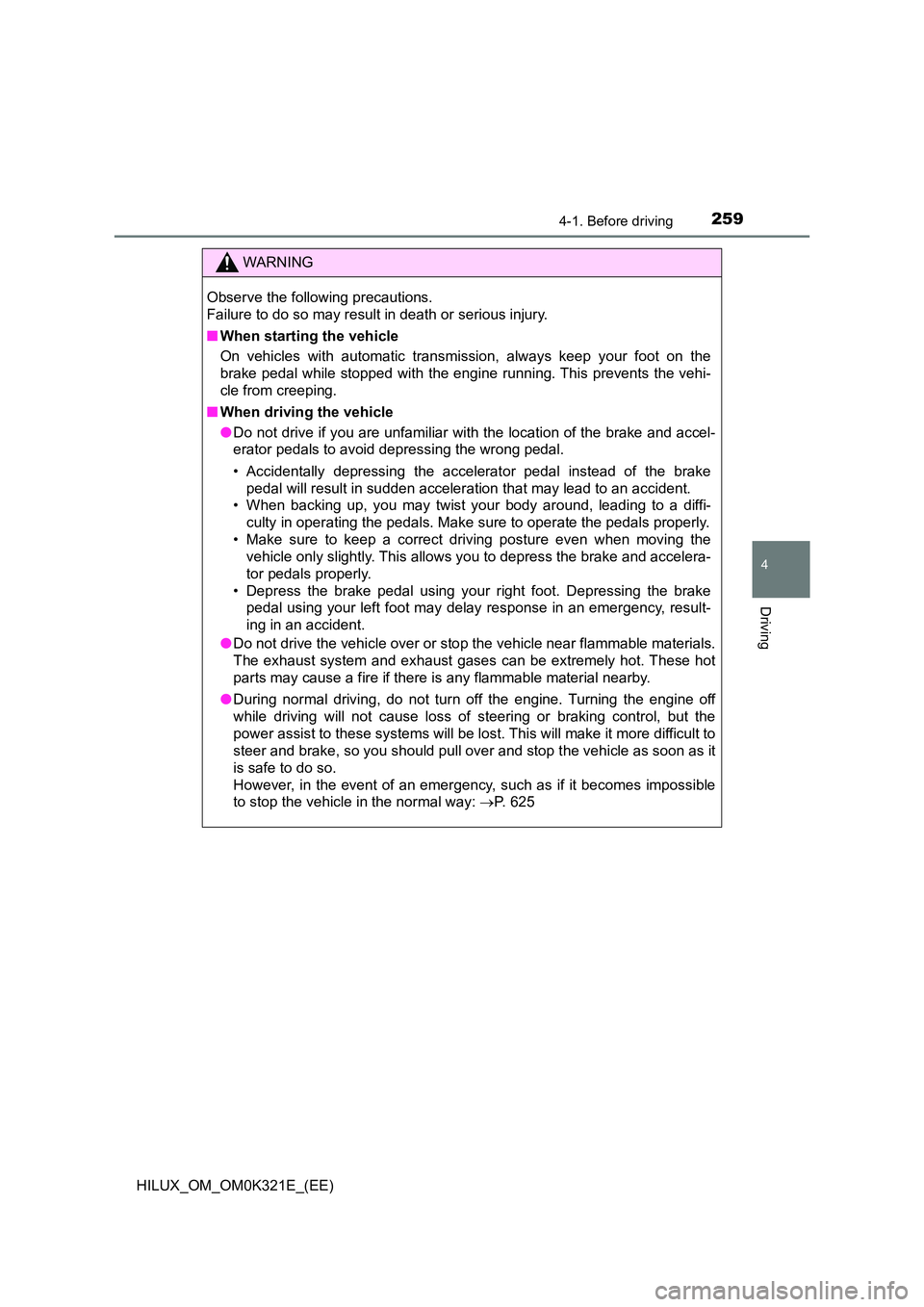
2594-1. Before driving
4
Driving
HILUX_OM_OM0K321E_(EE)
WARNING
Observe the following precautions.
Failure to do so may result in death or serious injury.
■ When starting the vehicle
On vehicles with automatic transmission, always keep your foot on the
brake pedal while stopped with the engine running. This prevents the vehi-
cle from creeping.
■ When driving the vehicle
● Do not drive if you are unfamiliar with the location of the brake and accel-
erator pedals to avoid depressing the wrong pedal.
• Accidentally depressing the accelerator pedal instead of the brake
pedal will result in sudden acceleration that may lead to an accident.
• When backing up, you may twist your body around, leading to a diffi-
culty in operating the pedals. Make sure to operate the pedals properly.
• Make sure to keep a correct driving posture even when moving the
vehicle only slightly. This allows you to depress the brake and accelera-
tor pedals properly.
• Depress the brake pedal using your right foot. Depressing the brake
pedal using your left foot may delay response in an emergency, result-
ing in an accident.
● Do not drive the vehicle over or stop the vehicle near flammable materials.
The exhaust system and exhaust gases can be extremely hot. These hot
parts may cause a fire if there is any flammable material nearby.
● During normal driving, do not turn off the engine. Turning the engine off
while driving will not cause loss of steering or braking control, but the
power assist to these systems will be lost. This will make it more difficult to
steer and brake, so you should pull over and stop the vehicle as soon as it
is safe to do so.
However, in the event of an emergency, such as if it becomes impossible
to stop the vehicle in the normal way: P. 625
Page 263 of 744
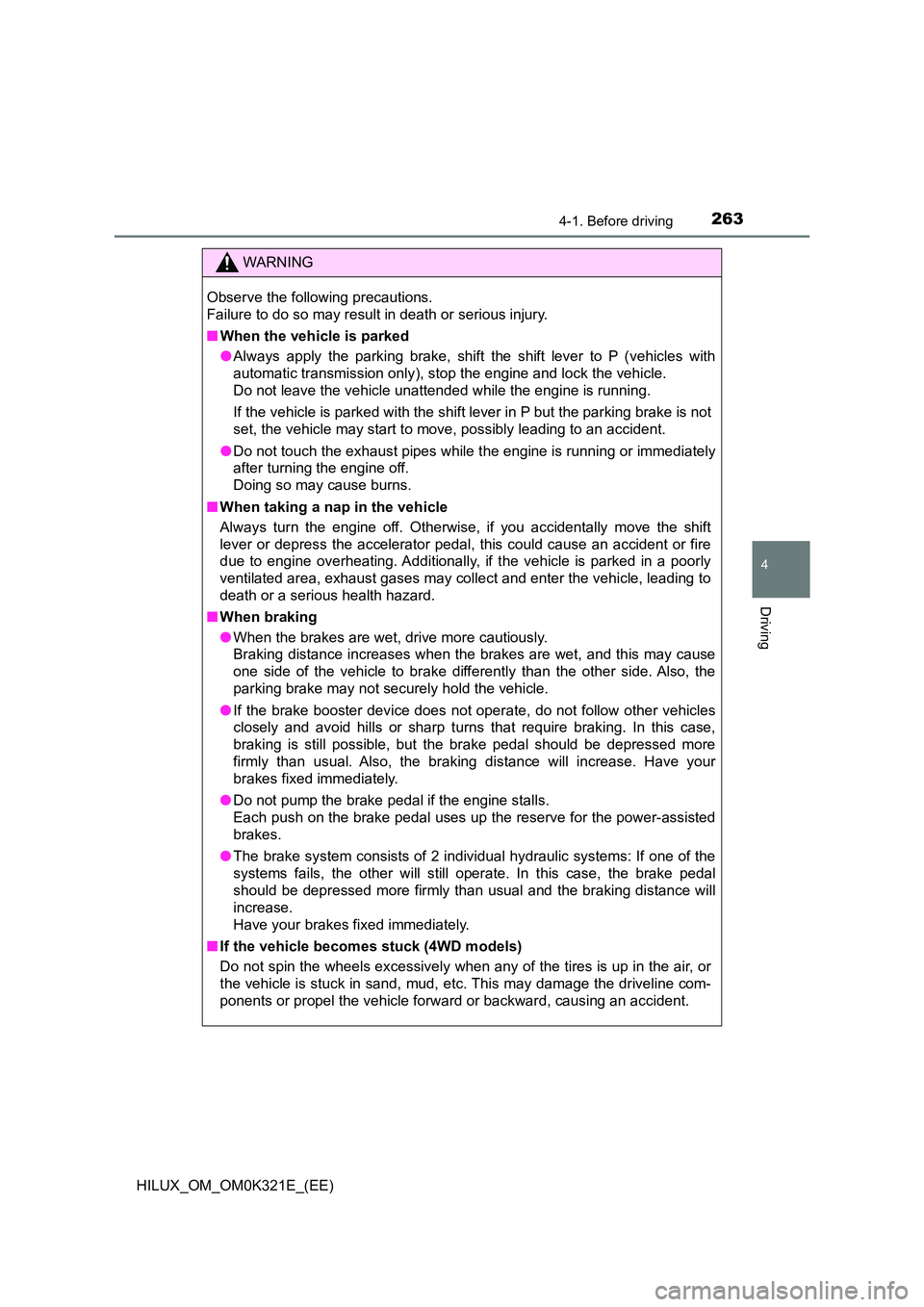
2634-1. Before driving
4
Driving
HILUX_OM_OM0K321E_(EE)
WARNING
Observe the following precautions.
Failure to do so may result in death or serious injury.
■ When the vehicle is parked
● Always apply the parking brake, shift the shift lever to P (vehicles with
automatic transmission only), stop the engine and lock the vehicle.
Do not leave the vehicle unattended while the engine is running.
If the vehicle is parked with the shift lever in P but the parking brake is not
set, the vehicle may start to move, possibly leading to an accident.
● Do not touch the exhaust pipes while the engine is running or immediately
after turning the engine off.
Doing so may cause burns.
■ When taking a nap in the vehicle
Always turn the engine off. Otherwise, if you accidentally move the shift
lever or depress the accelerator pedal, this could cause an accident or fire
due to engine overheating. Additionally, if the vehicle is parked in a poorly
ventilated area, exhaust gases may collect and enter the vehicle, leading to
death or a serious health hazard.
■ When braking
● When the brakes are wet, drive more cautiously.
Braking distance increases when the brakes are wet, and this may cause
one side of the vehicle to brake differently than the other side. Also, the
parking brake may not securely hold the vehicle.
● If the brake booster device does not operate, do not follow other vehicles
closely and avoid hills or sharp turns that require braking. In this case,
braking is still possible, but the brake pedal should be depressed more
firmly than usual. Also, the braking distance will increase. Have your
brakes fixed immediately.
● Do not pump the brake pedal if the engine stalls.
Each push on the brake pedal uses up the reserve for the power-assisted
brakes.
● The brake system consists of 2 individual hydraulic systems: If one of the
systems fails, the other will still operate. In this case, the brake pedal
should be depressed more firmly than usual and the braking distance will
increase.
Have your brakes fixed immediately.
■ If the vehicle becomes stuck (4WD models)
Do not spin the wheels excessively when any of the tires is up in the air, or
the vehicle is stuck in sand, mud, etc. This may damage the driveline com-
ponents or propel the vehicle forward or backward, causing an accident.
Page 291 of 744
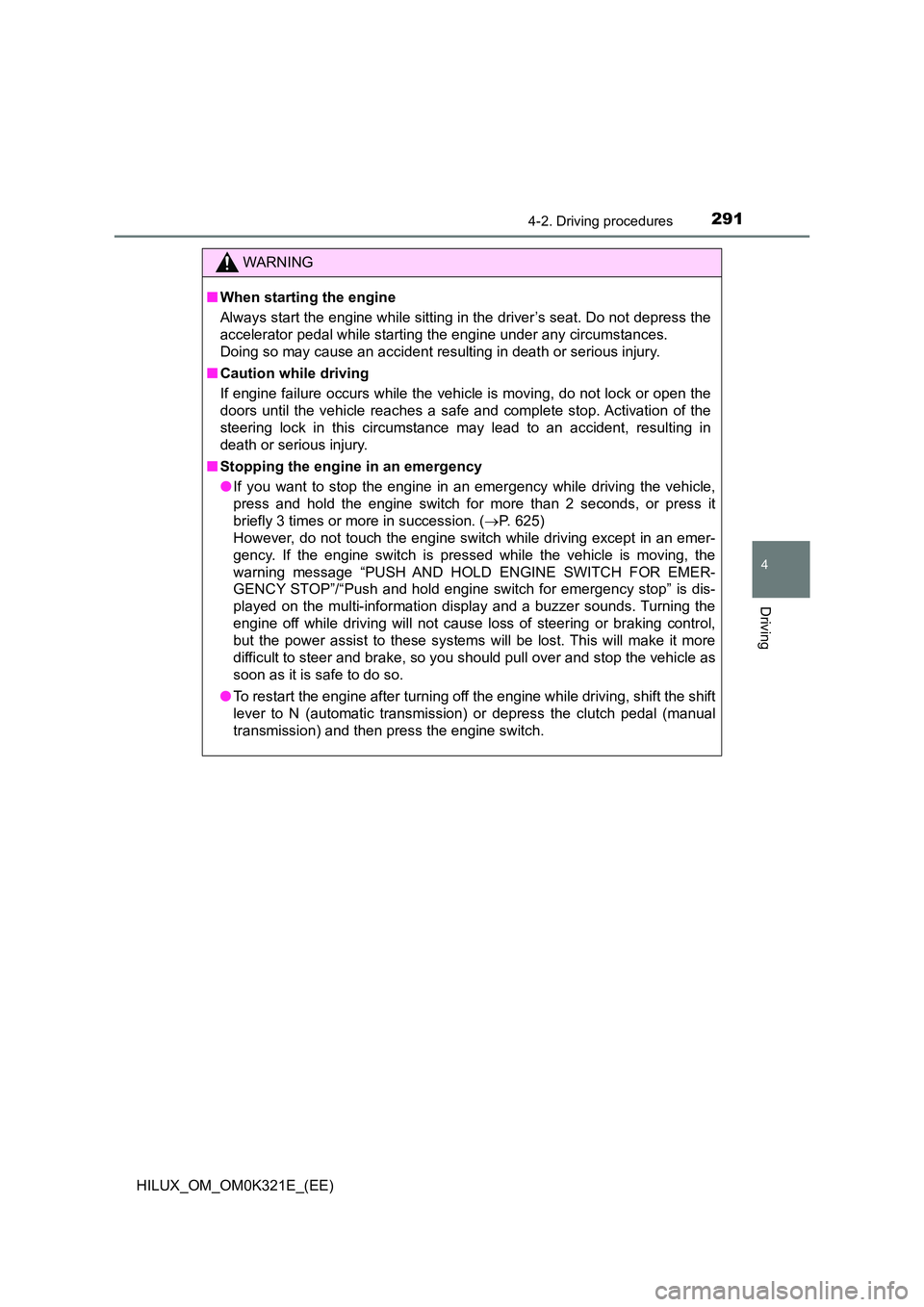
2914-2. Driving procedures
4
Driving
HILUX_OM_OM0K321E_(EE)
WARNING
■When starting the engine
Always start the engine while sitting in the driver’s seat. Do not depress the
accelerator pedal while starting the engine under any circumstances.
Doing so may cause an accident resulting in death or serious injury.
■ Caution while driving
If engine failure occurs while the vehicle is moving, do not lock or open the
doors until the vehicle reaches a safe and complete stop. Activation of the
steering lock in this circumstance may lead to an accident, resulting in
death or serious injury.
■ Stopping the engine in an emergency
● If you want to stop the engine in an emergency while driving the vehicle,
press and hold the engine switch for more than 2 seconds, or press it
briefly 3 times or more in succession. ( P. 625)
However, do not touch the engine switch while driving except in an emer-
gency. If the engine switch is pressed while the vehicle is moving, the
warning message “PUSH AND HOLD ENGINE SWITCH FOR EMER-
GENCY STOP”/“Push and hold engine switch for emergency stop” is dis-
played on the multi-information display and a buzzer sounds. Turning the
engine off while driving will not cause loss of steering or braking control,
but the power assist to these systems will be lost. This will make it more
difficult to steer and brake, so you should pull over and stop the vehicle as
soon as it is safe to do so.
● To restart the engine after turning off the engine while driving, shift the shift
lever to N (automatic transmission) or depress the clutch pedal (manual
transmission) and then press the engine switch.
Page 325 of 744
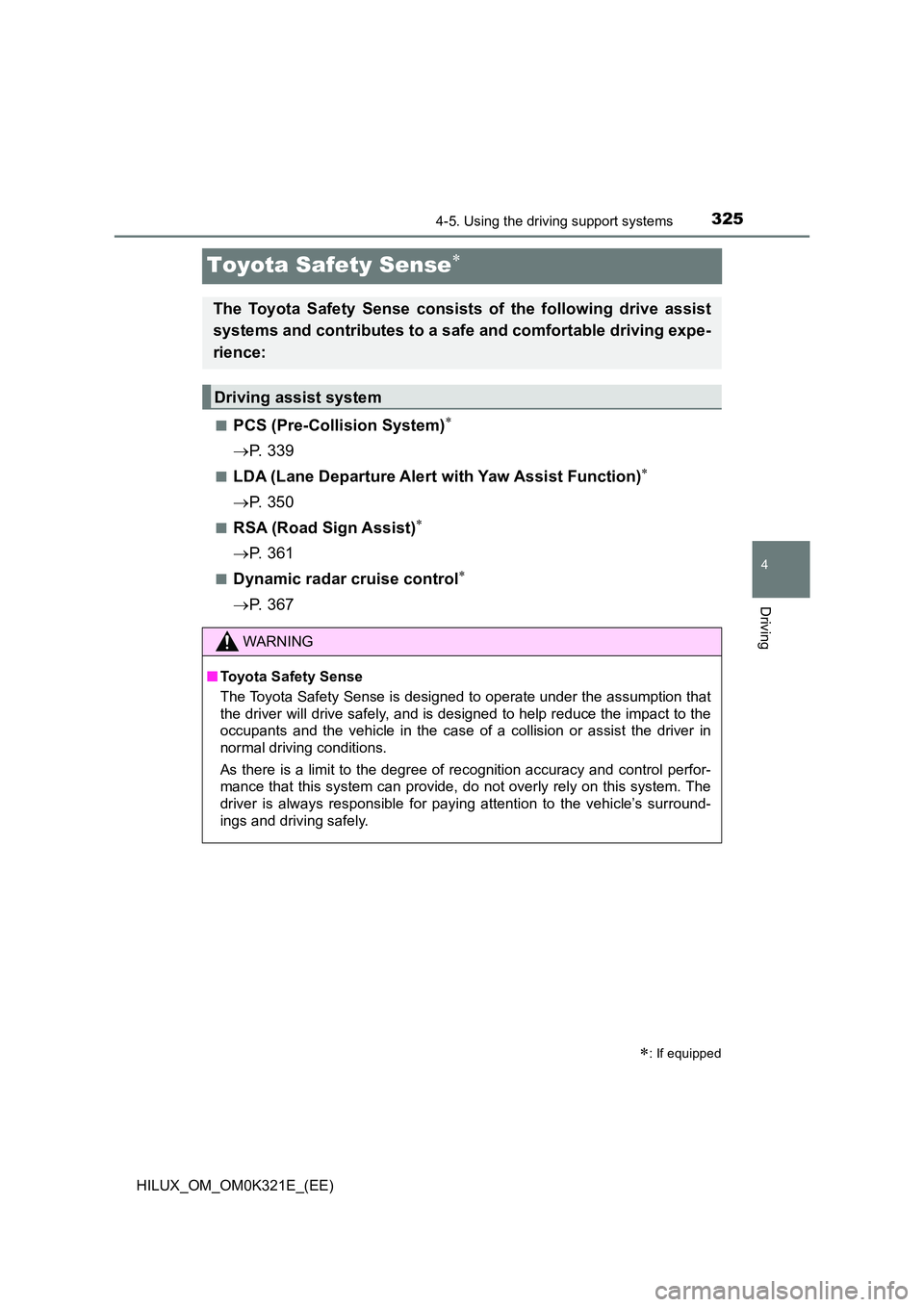
325
4
4-5. Using the driving support systems
Driving
HILUX_OM_OM0K321E_(EE)
Toyota Safety Sense
■PCS (Pre-Collision System)
P. 3 3 9
■LDA (Lane Departure Alert with Yaw Assist Function)
P. 3 5 0
■RSA (Road Sign Assist)
P. 3 6 1
■Dynamic radar cruise control
P. 3 6 7
: If equipped
The Toyota Safety Sense consists of the following drive assist
systems and contributes to a safe and comfortable driving expe-
rience:
Driving assist system
WARNING
■ Toyota Safety Sense
The Toyota Safety Sense is designed to operate under the assumption that
the driver will drive safely, and is designed to help reduce the impact to the
occupants and the vehicle in the case of a collision or assist the driver in
normal driving conditions.
As there is a limit to the degree of recognition accuracy and control perfor-
mance that this system can provide, do not overly rely on this system. The
driver is always responsible for paying attention to the vehicle’s surround-
ings and driving safely.
Page 326 of 744

3264-5. Using the driving support systems
HILUX_OM_OM0K321E_(EE)
Two types of sensors, located behind the front grille and windshield,
detect information necessary to operate the drive assist systems.
Radar sensor
Front camera
Sensors
1
2
Page 340 of 744
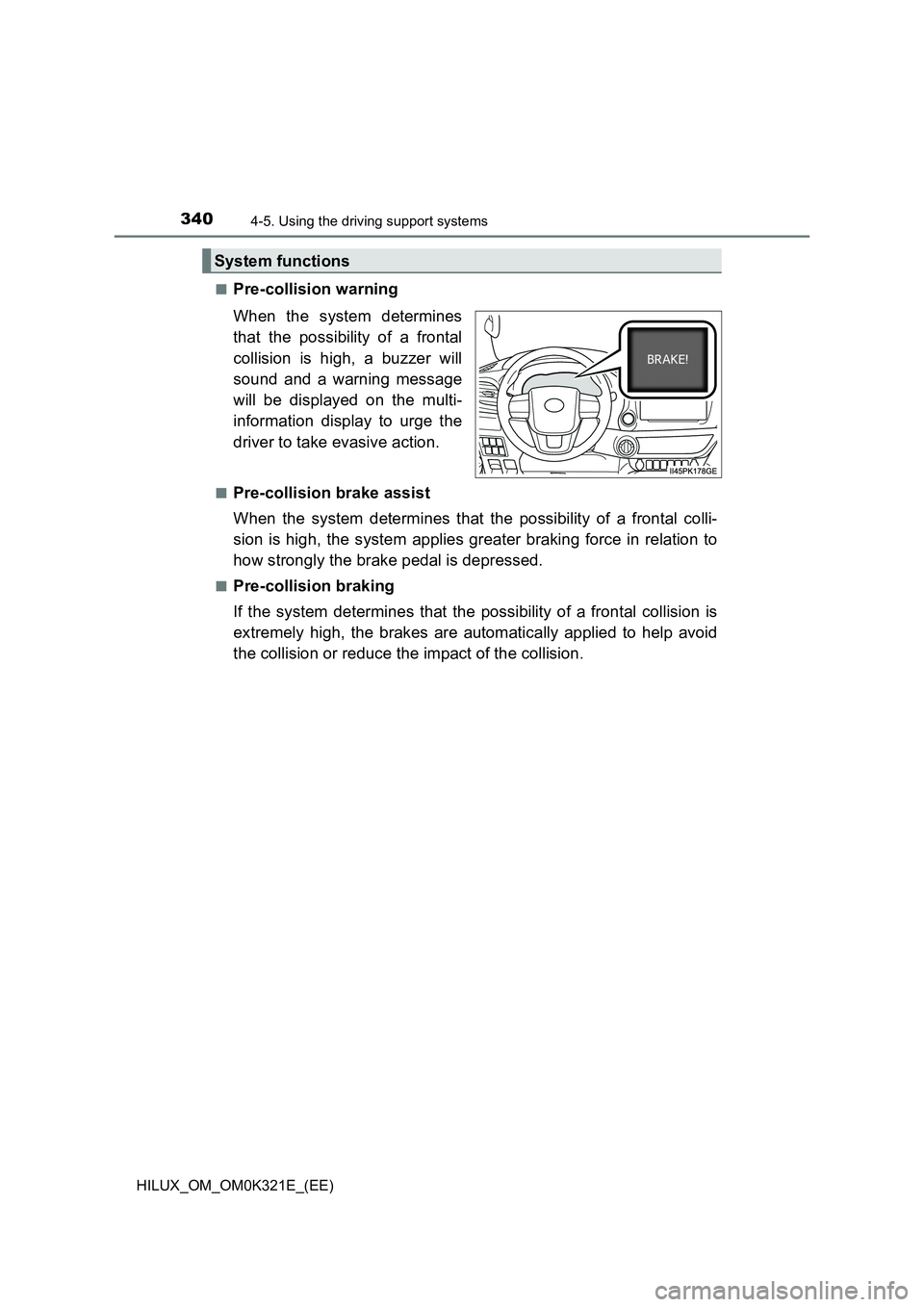
3404-5. Using the driving support systems
HILUX_OM_OM0K321E_(EE)
■Pre-collision warning
When the system determines
that the possibility of a frontal
collision is high, a buzzer will
sound and a warning message
will be displayed on the multi-
information display to urge the
driver to take evasive action.
■Pre-collision brake assist
When the system determines that the possibility of a frontal colli-
sion is high, the system applies greater braking force in relation to
how strongly the brake pedal is depressed.
■Pre-collision braking
If the system determines that the possibility of a frontal collision is
extremely high, the brakes are automatically applied to help avoid
the collision or reduce the impact of the collision.
System functions